spare wheel CHRYSLER 200 2012 1.G User Guide
[x] Cancel search | Manufacturer: CHRYSLER, Model Year: 2012, Model line: 200, Model: CHRYSLER 200 2012 1.GPages: 108, PDF Size: 2.83 MB
Page 73 of 108
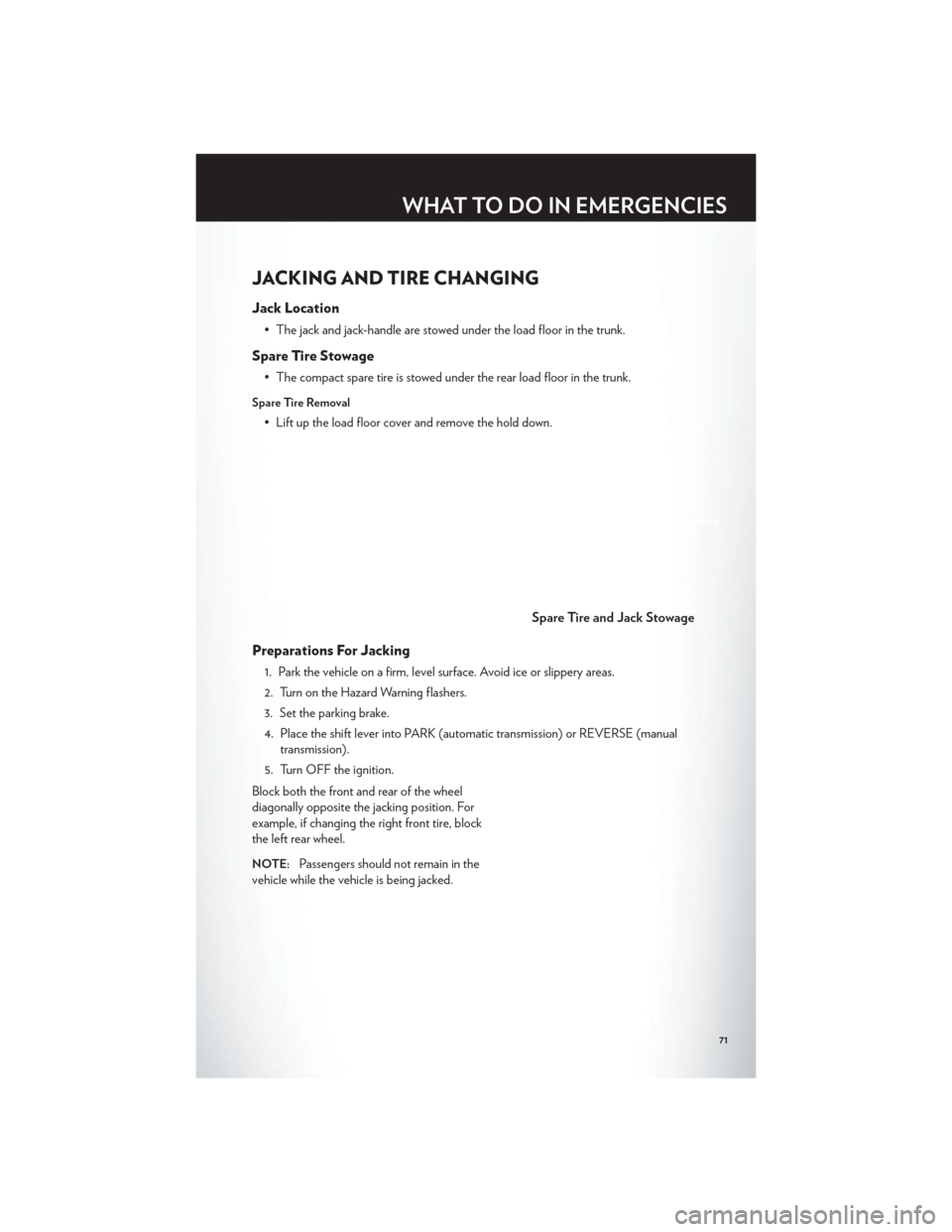
JACKING AND TIRE CHANGING
Jack Location
• The jack and jack-handle are stowed under the load floor in the trunk.
Spare Tire Stowage
• The compact spare tire is stowed under the rear load floor in the trunk.
Spare Tire Removal
• Lift up the load floor cover and remove the hold down.
Preparations For Jacking
1. Park the vehicle on a firm, level surface. Avoid ice or slippery areas.
2. Turn on the Hazard Warning flashers.
3. Set the parking brake.
4. Place the shift lever into PARK (automatic transmission) or REVERSE (manualtransmission).
5. Turn OFF the ignition.
Block both the front and rear of the wheel
diagonally opposite the jacking position. For
example, if changing the right front tire, block
the left rear wheel.
NOTE:Passengers should not remain in the
vehicle while the vehicle is being jacked.
Spare Tire and Jack Stowage
WHAT TO DO IN EMERGENCIES
71
Page 74 of 108
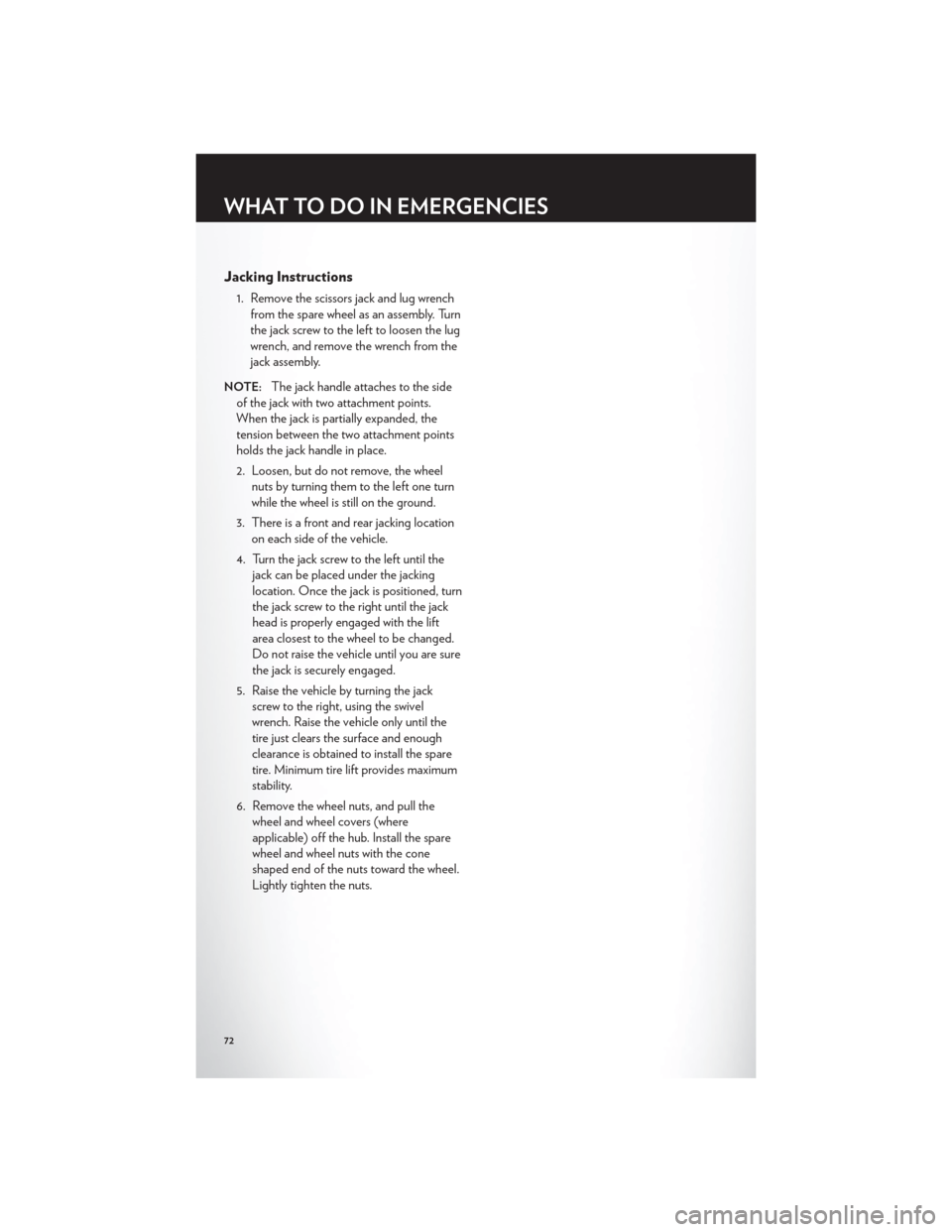
Jacking Instructions
1. Remove the scissors jack and lug wrenchfrom the spare wheel as an assembly. Turn
the jack screw to the left to loosen the lug
wrench, and remove the wrench from the
jack assembly.
NOTE:The jack handle attaches to the side
of the jack with two attachment points.
When the jack is partially expanded, the
tension between the two attachment points
holds the jack handle in place.
2. Loosen, but do not remove, the wheel nuts by turning them to the left one turn
while the wheel is still on the ground.
3. There is a front and rear jacking location on each side of the vehicle.
4. Turn the jack screw to the left until the jack can be placed under the jacking
location. Once the jack is positioned, turn
the jack screw to the right until the jack
head is properly engaged with the lift
area closest to the wheel to be changed.
Do not raise the vehicle until you are sure
the jack is securely engaged.
5. Raise the vehicle by turning the jack screw to the right, using the swivel
wrench. Raise the vehicle only until the
tire just clears the surface and enough
clearance is obtained to install the spare
tire. Minimum tire lift provides maximum
stability.
6. Remove the wheel nuts, and pull the wheel and wheel covers (where
applicable) off the hub. Install the spare
wheel and wheel nuts with the cone
shaped end of the nuts toward the wheel.
Lightly tighten the nuts.
WHAT TO DO IN EMERGENCIES
72
Page 75 of 108
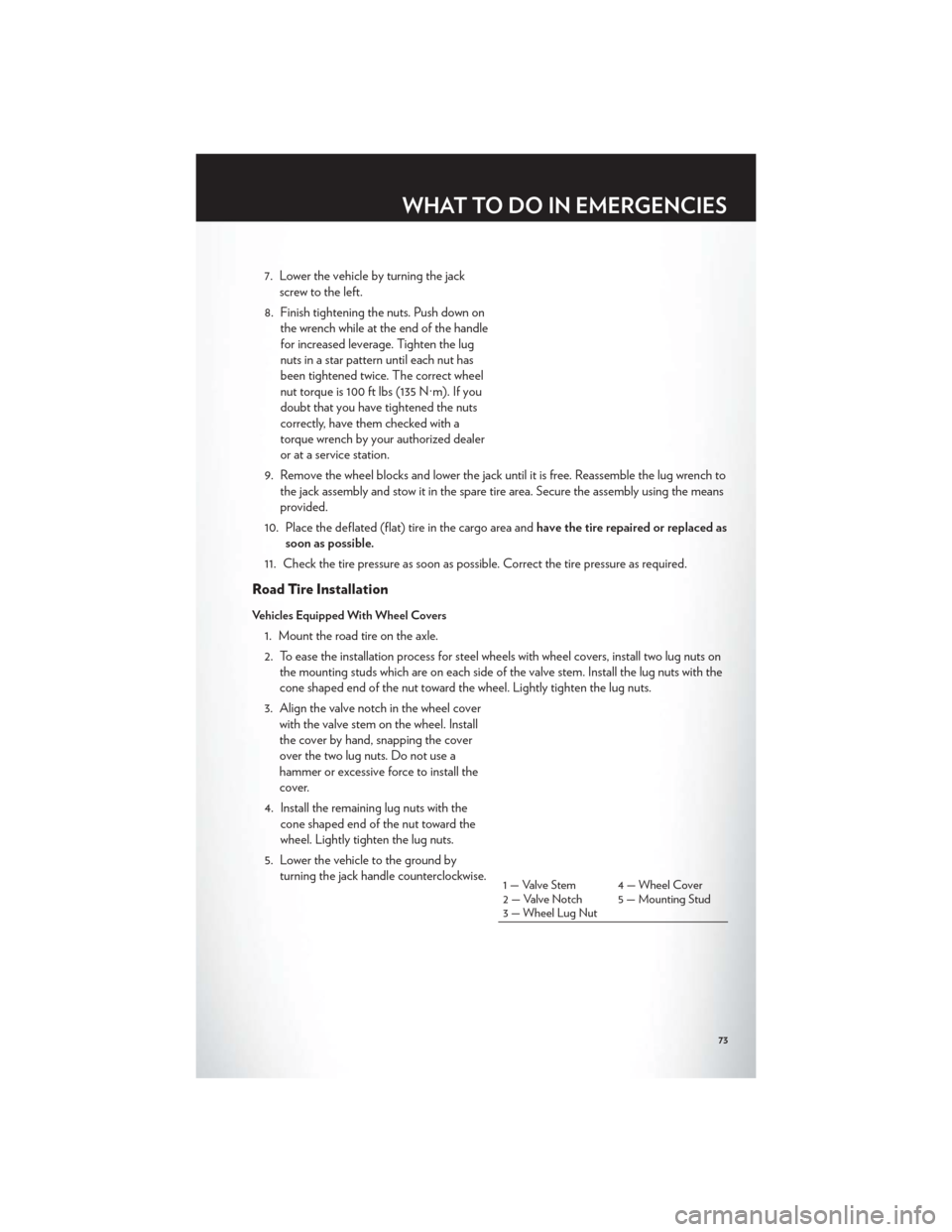
7. Lower the vehicle by turning the jackscrew to the left.
8. Finish tightening the nuts. Push down on the wrench while at the end of the handle
for increased leverage. Tighten the lug
nuts in a star pattern until each nut has
been tightened twice. The correct wheel
nut torque is 100 ft lbs (135 N·m). If you
doubt that you have tightened the nuts
correctly, have them checked with a
torque wrench by your authorized dealer
or at a service station.
9. Remove the wheel blocks and lower the jack until it is free. Reassemble the lug wrench to the jack assembly and stow it in the spare tire area. Secure the assembly using the means
provided.
10. Place the deflated (flat) tire in the cargo area and have the tire repaired or replaced as
soon as possible.
11. Check the tire pressure as soon as possible. Correct the tire pressure as required.
Road Tire Installation
Vehicles Equipped With Wheel Covers
1. Mount the road tire on the axle.
2. To ease the installation process for steel wheels with wheel covers, install two lug nuts on the mounting studs which are on each side of the valve stem. Install the lug nuts with the
cone shaped end of the nut toward the wheel. Lightly tighten the lug nuts.
3. Align the valve notch in the wheel cover with the valve stem on the wheel. Install
the cover by hand, snapping the cover
over the two lug nuts. Do not use a
hammer or excessive force to install the
cover.
4. Install the remaining lug nuts with the cone shaped end of the nut toward the
wheel. Lightly tighten the lug nuts.
5. Lower the vehicle to the ground by turning the jack handle counterclockwise.
1 — Valve Stem 4 — Wheel Cover
2 — Valve Notch 5 — Mounting Stud
3 — Wheel Lug Nut
WHAT TO DO IN EMERGENCIES
73
Page 76 of 108
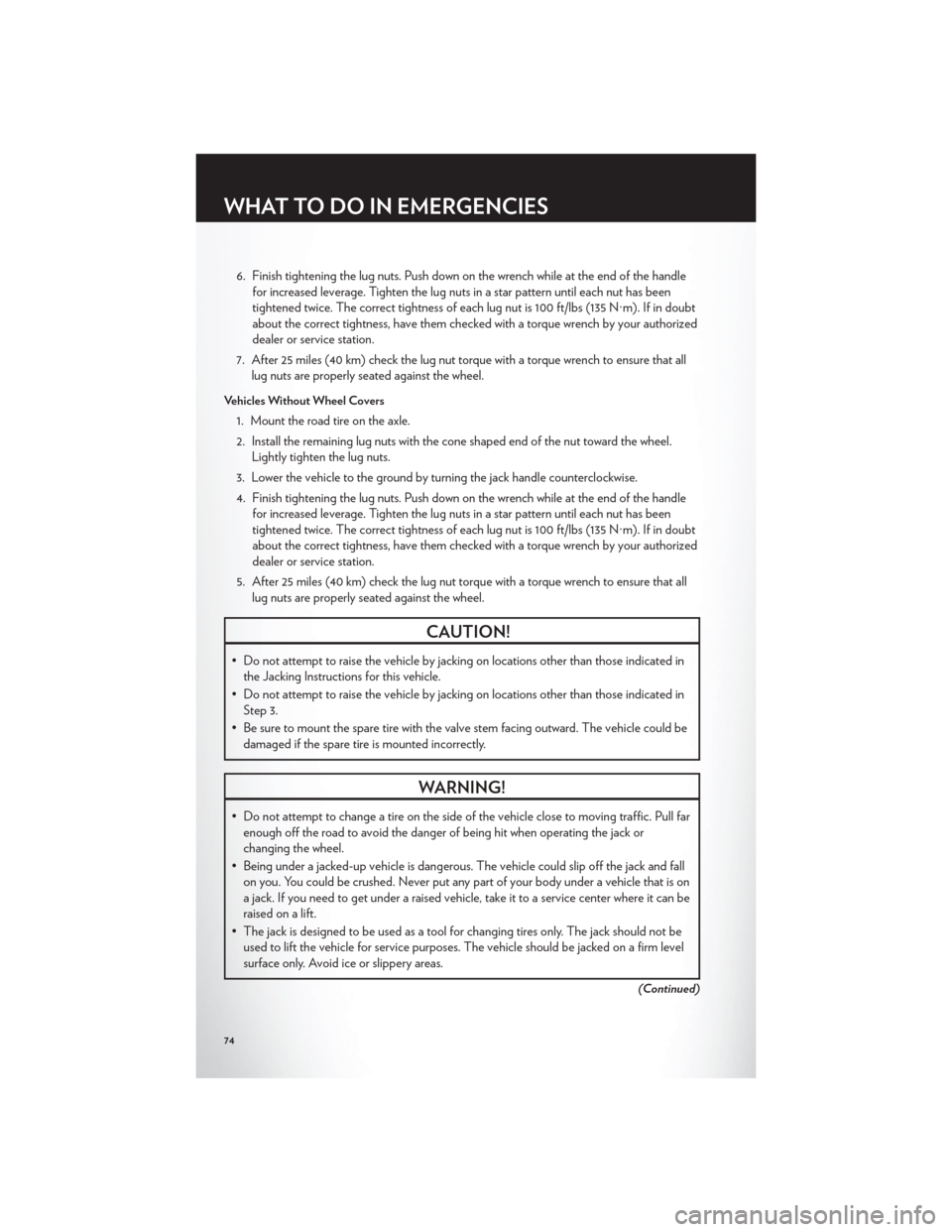
6. Finish tightening the lug nuts. Push down on the wrench while at the end of the handlefor increased leverage. Tighten the lug nuts in a star pattern until each nut has been
tightened twice. The correct tightness of each lug nut is 100 ft/lbs (135 N·m). If in doubt
about the correct tightness, have them checked with a torque wrench by your authorized
dealer or service station.
7. After 25 miles (40 km) check the lug nut torque with a torque wrench to ensure that all lug nuts are properly seated against the wheel.
Vehicles Without Wheel Covers
1. Mount the road tire on the axle.
2. Install the remaining lug nuts with the cone shaped end of the nut toward the wheel. Lightly tighten the lug nuts.
3. Lower the vehicle to the ground by turning the jack handle counterclockwise.
4. Finish tightening the lug nuts. Push down on the wrench while at the end of the handle for increased leverage. Tighten the lug nuts in a star pattern until each nut has been
tightened twice. The correct tightness of each lug nut is 100 ft/lbs (135 N·m). If in doubt
about the correct tightness, have them checked with a torque wrench by your authorized
dealer or service station.
5. After 25 miles (40 km) check the lug nut torque with a torque wrench to ensure that all lug nuts are properly seated against the wheel.
CAUTION!
• Do not attempt to raise the vehicle by jacking on locations other than those indicated inthe Jacking Instructions for this vehicle.
• Do not attempt to raise the vehicle by jacking on locations other than those indicated in Step 3.
• Be sure to mount the spare tire with the valve stem facing outward. The vehicle could be damaged if the spare tire is mounted incorrectly.
WARNING!
• Do not attempt to change a tire on the side of the vehicle close to moving traffic. Pull farenough off the road to avoid the danger of being hit when operating the jack or
changing the wheel.
• Being under a jacked-up vehicle is dangerous. The vehicle could slip off the jack and fall on you. You could be crushed. Never put any part of your body under a vehicle that is on
a jack. If you need to get under a raised vehicle, take it to a service center where it can be
raised on a lift.
• The jack is designed to be used as a tool for changing tires only. The jack should not be used to lift the vehicle for service purposes. The vehicle should be jacked on a firm level
surface only. Avoid ice or slippery areas.
(Continued)
WHAT TO DO IN EMERGENCIES
74
Page 77 of 108
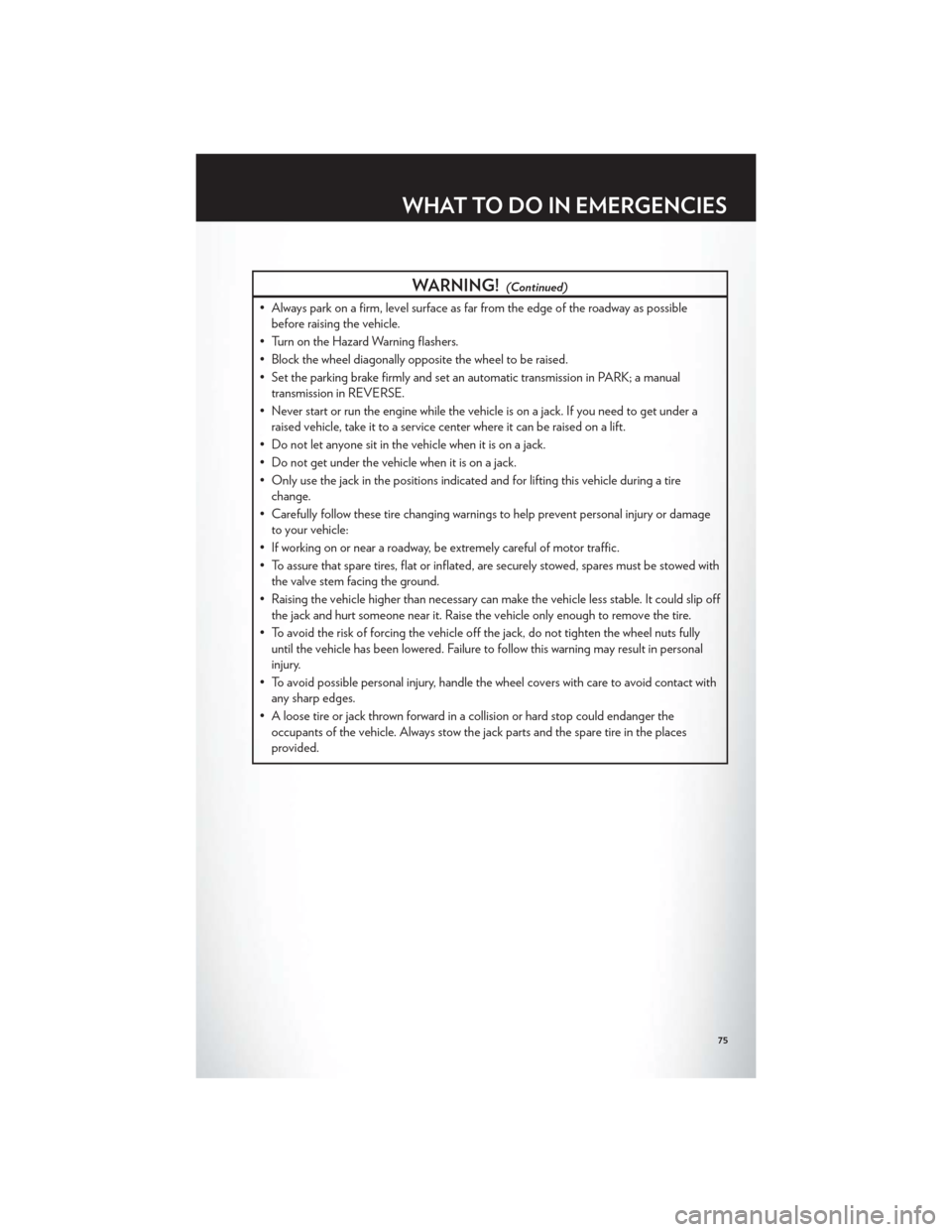
WARNING!(Continued)
• Always park on a firm, level surface as far from the edge of the roadway as possiblebefore raising the vehicle.
• Turn on the Hazard Warning flashers.
• Block the wheel diagonally opposite the wheel to be raised.
• Set the parking brake firmly and set an automatic transmission in PARK; a manual transmission in REVERSE.
• Never start or run the engine while the vehicle is on a jack. If you need to get under a raised vehicle, take it to a service center where it can be raised on a lift.
• Do not let anyone sit in the vehicle when it is on a jack.
• Do not get under the vehicle when it is on a jack.
• Only use the jack in the positions indicated and for lifting this vehicle during a tire change.
• Carefully follow these tire changing warnings to help prevent personal injury or damage to your vehicle:
• If working on or near a roadway, be extremely careful of motor traffic.
• To assure that spare tires, flat or inflated, are securely stowed, spares must be stowed with the valve stem facing the ground.
• Raising the vehicle higher than necessary can make the vehicle less stable. It could slip off the jack and hurt someone near it. Raise the vehicle only enough to remove the tire.
• To avoid the risk of forcing the vehicle off the jack, do not tighten the wheel nuts fully until the vehicle has been lowered. Failure to follow this warning may result in personal
injury.
• To avoid possible personal injury, handle the wheel covers with care to avoid contact with any sharp edges.
• A loose tire or jack thrown forward in a collision or hard stop could endanger the occupants of the vehicle. Always stow the jack parts and the spare tire in the places
provided.
WHAT TO DO IN EMERGENCIES
75
Page 100 of 108

StartingRemote .................8
Steering Tilt Column ...............16
Steering Wheel Audio Controls ......52
Store Radio Presets ........... 27,29
SunRoof..................22
Supplemental Restraint System - Airbag . . 10
Text Messaging ..............57
Theft Alarm (Security Alarm) ........9
Theft System Arming ............9
Theft System Disarming ..........9
Tilt Steering Column ............16
Ti re s Air Pressure ...............91
Changing ................71
Jacking .................71
Pressure Warning Light .........66
SpareTire ................71
Towing ..................64 24-Hour Towing Assistance .......66Disabled Vehicle
............79
Recreational ..............65
Trailer Towing Trailer and Tongue Weight .......64
Trailer Weight ...............64
Transmission Fluid ..................85
Turn Signals ................18
Uconnect™ Phone .............53
Uconnect™ Voice Command ........56
Voice Commands .............56
Washers, Windshield ............19
Wheel and Wheel Trim Care ........92
Wind Buffeting ..............23
Windshield Washers ............19
Windshield Wipers .............19
Wipers, Intermittent ............19
INDEX
98